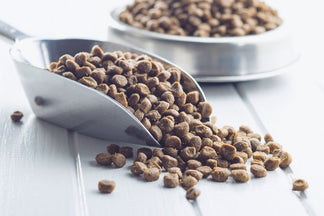Grain free pet food is one of the fasting growing segments in the pet food industry. GfK Research recently reported that sales of grain free pet food grew a whopping 28% from September 2012 to September 2013 in US retail stores. For comparison, the American Pet Products Association 2013 Survey and Forecast reported that overall sales of pet food will grow by 4.78 % in 2014.
The same GfK study also reported that grain-free product sales during that period were $1.7 billion and account for about one-third of all new pet items introduced each month. In the past year, the number of grain-free pet products has grown 33%, to over 3,500 on shelves today – about 2,300 for dogs, versus roughly 1,200 for cats.
Obviously, grain free products are “hot” and becoming more popular for pet owners. The question is, are they worth it or not?
What is Grain?
According to Wikipedia, grains are small, hard, dry seeds, with or without attached hulls or fruit layers. The two main types of commercial grain crops are cereals such as wheat and rye and legumes such as beans and soybeans. The grains most often referred to in pet food are the cereal group.
Grains are a source of fiber and can be relatively high in protein. Commonly used cereal grains in pet food include rice, oats, wheat, and sorghum. Corn is another common grain ingredient although it is also classified as both a vegetable and a fruit.
Popularity of Grain Free Pet Food
So what is driving the rapid growth in grain free pet food? Dog and cat owners are becoming more aware that their pet’s bodies were meant to digest foods high in protein and fat and lower in carbohydrates. The mistake they are making is equating grain free with low carb. Using the SlimDoggy dog food database, I compared the average macronutrient profile (protein, fat, and carbs) of grain free dog foods to all foods. The results are shown in the graph below.

It turns out that while grain free foods are in fact slightly lower in carbs (and higher in protein and fat) than non-grain free foods, the difference is not very large. The average grain free dog food still contains a higher carb content than protein content. Choosing a grain free product might help, but it wont necessarily fulfill your pet’s macronutrient requirements.
Is your Pet’s Food Low in Carbs?
If you want to make sure that your pet is eating a lower carb food, choosing a ‘grain free’ food will not necessarily accomplish this. Instead, start with an inspection of the macronutrient profile (on a dry matter basis), which will show you approximate protein, fat, and carb percentages based on the label’s guaranteed analysis. If you see foods that have more carbs than protein and fat combined, be wary! Dogs are descendants of the carnivore wolf and their bodies are meant to tolerate diets higher in protein and fat, assuming that there is no medical reason that requires a different mix. Cats are obligate carnivores so it is even more essential that they be fed a high protein, high fat diet.
Do you feed your pet a grain free food? If so, is it really a low carb food?

 Food
Food
 Food
Food
 Food
Food
